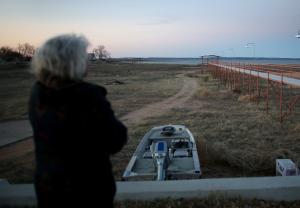 |
| Frozen waves are photographed on Nantucket, Massachusetts. Photo by Jonathan Nimerfroh used by permission |
Photographer was shocked to see ‘Slurpee waves’; a day later, ocean was frozen
The unusually cold winter of Massachusetts produced an incredible phenomenon 100 miles southeast of Boston on the island of Nantucket recently: frozen waves, or, as some are describing them, Slurpee waves.
Photographer Jonathan Nimerfroh had just finished a photo shoot when he decided to check out the beach, since they surf there in the winter.
He told GrindTV that the horizon had an eerie look to it, and upon closer inspection he discovered something very unusual.
“When I got to the top of the dunes, I could see that about 300 yards out from the shoreline the ocean was starting to freeze,” he told Shutterbug.com.
Waves were turning to slush, so Nimerfroh started taking photos of the Slurpee waves and the images started going viral Thursday.

Frozen waves are photographed on Nantucket, Massachusetts. Photo by Jonathan Nimerfroh used by permission

Frozen wave of Nantucket. Photo by Jonathan Nimerfroh used by permission

Frozen wave of Nantucket. Photo by Jonathan Nimerfroh used by permission

Frozen wave of Nantucket. Photo by Jonathan Nimerfroh used by permission
The high temperature of the day was 19 degrees Fahrenheit and the wind was howling from the southwest, which would typically make rough or choppy conditions not good for surfing, Nimerfroh explained to Shutterbug.com.
“But since the surface of the sea was frozen slush, the wind did not change the shape,” he said. “They were perfect dreamy slush waves.
“What an experience to be absolutely freezing on the beach watching these roll in while I mind-surfed them. I wonder if a shaper can make me a special-designed slurfboard?”
The next day, Nimerfroh went back to see if the waves had melted and discovered another oddity: The same 300-yard stretch out into the ocean was frozen on the surface. It was 10 inches thick.
“No waves at all,” he told Shutterbug.com. “I’ve been asking all the fishermen and surfers if they have ever seen such a thing. This is a first, they all said.”
It fits in quite nicely to the Massachusetts winter of firsts, then.
Original post found here: http://www.grindtv.com/lifestyle/in-style/post/frozen-waves-captured-nantucket-surf-photos/








